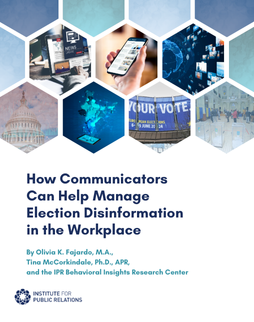First published in The Measurement Standard, this is an interview by Editor Bill Paarlberg with David Geddes, Managing Director of Geddes Analytics and past Chair of the IPR Measurement Commission of the Institute for Public Relations. He is Chair of the Coalition for Public Relations Research Standards, the group of industry leaders that have developed standards for the measurement of public relations.
TMS: Hello David, thanks for speaking with us. How would you sum up the current state of measurement standards?
David Geddes: Glad to be here. The short answer is that the standards process has come along very well; we now have basic standards in place and are encouraging people to pledge to support them.
For a longer answer, let’s start by considering a spectrum of standards and best practices for public relations measurement. (Here I’ll use the terms “standards” and “best practices” as parts of one concept.) At one end of the spectrum are the simplest standards, for example a definition of “mention” in social media analysis and a specification of how mentions be calculated. The main complexity here is how to treat company nicknames such as “Mickey D’s,” stock ticker symbols, and other name variants. This base level standard is analogous to, say, a mechanical standard for threads per centimeter on a bolt.
At the other end of the spectrum is a hypothetical “killer standard” (or best practice) that links (i) public relations activities, (ii) outputs, (iii) engagement, (iv) cognitive change, often referenced as outtakes, (v) behaviors, and (vi) desired organizational outcomes. There remains active debate both in the profession and in the academic literature about what this type of best practice might look like.
The Coalition decided to address the base level standards first, for two reasons. First, we wanted to build cooperation, communication, and engagement among industry players by starting simply, where there was the greatest likelihood of reaching consensus. This would pave the way for handling more complex standards and best practices. This, by the way, is what the Barcelona Principles achieved earlier: They were the first time that a broad representation of industry players ever agreed to anything, apart from where to go for a drink after the conference sessions. This was no small feat, and the individuals who worked on the principles and organized the European Measurement Summit deserve much credit.
Second, the hypothetical “killer standard” would be build upon base level definitions, guidelines, and standards. Consequently the base level seemed the right place to start. Furthermore, it is quite possible that this “killer standard” is the level where industry players should be competing for the best approach, and so there will never be a final standard in the true sense of the term.
Today, we have sets of standards for traditional media analysis, for social media analysis, for the communications life cycle (beginning with awareness and extending to advocacy), for return on investment, and for ethics in research and measurement. These have been available to the profession for almost two years for testing, for comment, and for revision. Four major corporations have adopted these standards, and are working internally and with their external agency and measurement partners to apply them. These companies will be reporting on their experience over the course of the year.
In one case, several standards for traditional media analysis were rigorously tested for reliability (O’Neal, Eisenmann, and Geddes, 2014).
From the outset, the Coalition has expected to receive and has welcomed comments and suggestions concerning these standards from businesses, non-profits, NGOs, agencies, measurement firms, and academia.
TMS: What fraction of standards are completed, and what fraction still in progress?
D.G.: The simple answer is that we now have a foundation, but we don’t know how many further standards will be developed.
As described by the International Organization for Standardization, standards are developed and adopted in response to the needs expressed by the marketplace. The Coalition started with a logical set of standards, many in the areas of media analysis and social media analysis. This decision was based purely on demand from industry professionals, and does not reflect a greater or lesser importance of these measures of outputs within the greater scheme of public relations measurement.
Further standards will be developed as requested by the industry. For example, should there be standards for employee communications measurement and evaluation? Or for investor relations? I would ask that practitioners who see a need for a specific standard contact the Coalition to discuss the need and next steps.
TMS: What state is the measurement industry now in? What fraction adheres, more or less, to the standards?
D.G.: Let me give you a a few examples on the positive side. The quality of applications for measurement awards is higher than ever. Papers that received a Jack Felton Golden Ruler Award from the Institute for Public Relations ten years ago would not be so competitive any longer. Public relations degree programs across the country are devoting more time to public relations research, measurement, and evaluation. Consequently the new generation of public relations professionals has grounding in research design, statistical analysis, and how to plan measurement programs.
On the negative side, Wright et al (2009) report that, based on an industry survey, AVEs remained the third most-used metrics, employed by 35% of industry practitioners. Anecdotally, judges for major industry awards have told me that the lack of adequate measurement against objectives allows screening out 80% of award applications.
Compliance with standards will require time and is voluntary. The Coalition does not have and does not intend to develop any auditing or policing process. Our aspiration is that the marketplace will favor those who clearly comply with standards.
I encourage companies and other organizations to pledge their support for the standards.
TMS: What has the feedback been from organizations? Has it been a valuable help in developing the standards?
D.G.: This is where the customer panel established by the Coalition plays a central role. The four companies that have adopted the standards—General Motors, General Electric, McDonald’s, and Southwest Airlines—report that they are using the standards for internal training, and they’ve expressed an expectation that their external partners adopt the standards. Anecdotally, one customer panel member estimated that bringing suppliers into compliance required about one hour of work with each external partner. We expect to conduct webinars and/or publish articles about the implementation experiences of these companies.
While on this subject, the Coalition would welcome additional members of its customer panel, especially those based outside of the U.S. Interested organizations should contact Frank Ovaitt at the Institute for Public Relations or myself.
TMS: What are the next steps?
D.G.: First, we would like companies, agencies, and measurement firms to learn about the available standards, pledge to support the standards initiative, apply the standards in their work, provide feedback on the standards, and, where needed, suggest new standards needed in the profession.
For client organizations, we would like to see an expectation that their external partners—agencies, research/measurement partners, and consultants—adhere to the standards. To this end, we are making available standard language for client organizations to include in RFPs, for example.
For agencies and research/measurement firms we would like to see that they adopt the standards, educate their internal teams about the standards, and that they pledge their support for standards. To this end, we are making available standard language for inclusion in proposals and reports concerning adherence to standards.
TMS: How can the ordinary PR pro in the trenches best make use of the new standards? Is there a good way to ease into adoption? Like maybe just use the Transparency Table?
D.G.: The transparency table is a good first step, because the table forces the practitioner to document what she or he is currently doing. Self-assessment is a necessary first step to improvement.
The standards are actually an integrated package. The first big step is the commitment. Once the individuals adopt the definitions and measurement protocols, the subsequent steps should be easier. There are many resources available, including contacting the International Association for the Measurement and Evaluation of Communication (AMEC) or the Institute for Public Relations Measurement Commission.
The standards are most directly relevant, on a day-to-day basis, to team members involved in research, measurement, and evaluation. Consequently, it may be the research group within an agency, or the person within an agency who has the most experience in measurement, who will apply the standards.
The role of an account team lead at an agency, for example, would be to insist that the team and its measurement partners, if any, use the standards. An ordinary public relations professional has lots of things to do already.
TMS: We know there is a push to Sign the Pledge. How is this going? To what extent will peer pressure be effective in increasing adoption? Do you have some kind of accreditation program for organizations? Or perhaps a Gold Star Seal of Approval?
D.G.: The opportunity to pledge support is important. We have about 30 signatories already, and we expect more as awareness grows. As the ISO notes, the marketplace drives the adoption of standards. So, in that sense, yes, we expect peer pressure and client expectations to drive the adoption of standards.
The Coalition does not have and does not plan on having an accreditation program, a certification program, or a seal of approval.
TMS: Thanks for speaking with us, David.
D.G.: My pleasure, thank you.
Eisenmann, M, O’Neil, J, & Geddes, D, (2014) An Examination of the Validity, Reliability and Best Practices Related to the Proposed Standards for Traditional Media.
Wright D, Gaunt R, Leggetter B, et al. (2009) Global survey of communications measurement 2009 – final report. London, UK: Association for Measurement and Evaluation of Communication.



